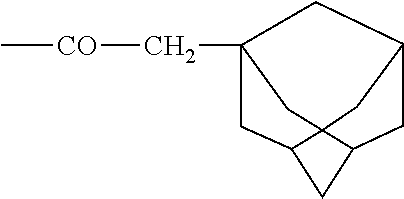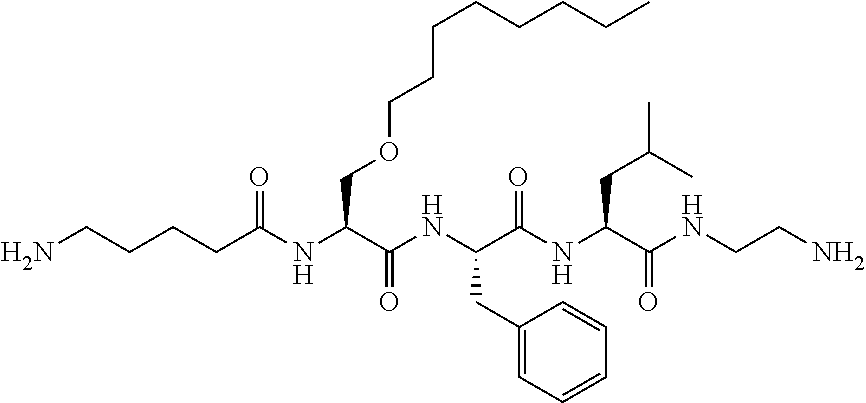Methods of treating traumatic brain injury
- Summary
- Abstract
- Description
- Claims
- Application Information
AI Technical Summary
Benefits of technology
Problems solved by technology
Method used
Image
Examples
example 1
ariants Prevent Disruption of the Blood-Brain Barrier after Severe or Moderate TBI
[0724]The ghrelin variant reduces neuronal damage from post severe or moderate TBI inflammation and blood-brain barrier (BBB)-mediated edema. The ghrelin variant modulates cerebral vascular permeability and mediates BBB breakdown following severe or moderate TBI. Using a weight-drop model, severe or moderate TBI is created in three groups of mice: 1) sham, 2) severe or moderate TBI, and 3) severe or moderate TBI / ghrelin variant. The BBB is investigated by examining its permeability to FITC-dextran and through quantification of perivascualar aquaporin-4 (AQP-4). Serum S100B is used as a marker of brain injury. Compared to sham, severe or moderate TBI causes significant histologic neuronal degeneration, increased in vascular permeability, perivascular expression of AQP-4, and serum levels of S100B. Treatment with the ghrelin variant mitigates these effects; after severe or moderate TBI, ghrelin variant-t...
example 2
of Ghrelin Variants in Experimental Severe or Moderate Traumatic Brain Injury
[0737]Adult rats are subjected to an impact acceleration injury resulting in reproducible severe or moderate traumatic brain injury, as described in Marmarou et al. (The impact acceleration injury model in rats, J Neurosurg. 80:291-300 (1994)), incorporated herein by reference. Three groups of rats receive dietary supplementation. Group 1 receives dietary supplementation with a ghrelin variant daily. Group 2 serves as an un-supplemented control, and Group 3 undergoes sham injury and received no supplementation.
[0738]Following 30 day post-injury, surviving animals are euthanized with a lethal dose injection of 0.5 ml Ketamine and 0.5 ml Xylazine. The animals are immediately perfused transcardially to wash out all blood. This is followed by 4% paraformaldehyde. The entire brain, brainstem, and rostral spinal cord of the animals are removed and immediately place in 4% paraformaldehyde for 24 hours fixation. Fo...
example 3
bility of Ghrelin Variants to GHS-R
[0740]The binding ability of ghrelin variants to GHS-R can be determined by a binding assay. Chinese hamster ovary cell line cells, CHO-K1, are prepared to express the human recombinant GHS receptor.
[0741]The cells can be prepared by any suitable method. One such method can include: The cDNA for human growth hormone secretagogue receptor (hGHS-Rla, or ghrelin receptor) is cloned by Polymerase Chain Reaction (PCR) using human brain RNA as a template (Clontech, Palo Alto, Calif.), gene specific primers flanking the full-length coding sequence of hGHS-R, (S: 5′-ATGTGGAACGCGACGCCCAGCGAAGAG-3′ (SEQ ID NO: 39) and AS: 5′-TCATGTATTAATACTAGATTCTGTCCA-3′ (SEQ ID NO: 40)), and Advantage 2 PCR Kit (Clontech). The PCR product is cloned into the pCR2.1 vector using Original TA Cloning Kit (Invitrogen, Carlsbad, Calif.). The full length human GHS-R is subcloned into the mammalian expression vector pcDNA 3.1 (Invitrogen). The plasmid is transfected into the Chine...
PUM
| Property | Measurement | Unit |
|---|---|---|
| Fraction | aaaaa | aaaaa |
| Fraction | aaaaa | aaaaa |
| Fraction | aaaaa | aaaaa |
Abstract
Description
Claims
Application Information
 Login to View More
Login to View More - R&D
- Intellectual Property
- Life Sciences
- Materials
- Tech Scout
- Unparalleled Data Quality
- Higher Quality Content
- 60% Fewer Hallucinations
Browse by: Latest US Patents, China's latest patents, Technical Efficacy Thesaurus, Application Domain, Technology Topic, Popular Technical Reports.
© 2025 PatSnap. All rights reserved.Legal|Privacy policy|Modern Slavery Act Transparency Statement|Sitemap|About US| Contact US: help@patsnap.com



